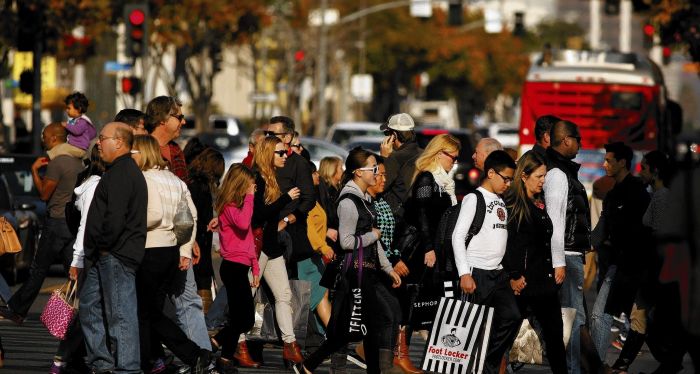How Smart Retailers Take Advantage of Broadband To Beat The Recession
Views, News & more

The credit crunch hit many retailers hard. But some are fighting back, by capitalising on six key trends that broadband has unleashed:
E-commerce – A Segment of Retail That’s Growing
The traditional high-street may be suffering, but there are bright spots. E-commerce is growing rapidly, as consumers embrace the convenience, value and choice offered by online shopping.
E-commerce provides an opportunity for small and mid-sized retailers to punch above their weight. A modest retail footprint isn’t much of an impediment online, as a single warehouse and a courier company are the only things needed to deliver products nationwide. Online, there is infinite shelf-space, allowing retailers to offer a larger range of products than they could carry in their stores.
E-commerce favours the agile. Small and mid-sized retailers may have an advantage here, as they may have greater freedom to tweak page layouts, post-purchase offers, and search engine optimisation strategies than larger rivals.
M-Commerce – Smartphones and Tablets Use Surges
Broadband may have given consumers a taste for the Internet, but the way those consumers are accessing the net is changing rapidly.
According to UK communications regulator OFCOM, from 2011 to 2012 tablet ownership jumped from 2% of the population to 11%, and smartphone ownership jumped from 27% to 39%.
Smart retailers no longer assume their web sites and emails will be viewed on a desktop PC. They’ve adapted them to work well on smaller displays that have touch-screen input. Some retailers are even developing their own mobile & tablet applications that offer in-app purchasing, product information, branch finders and content.
Real-time Information – For faster, better management decisions. Enabling new services
Retailers are increasingly using their retail WANs to transfer transaction data, stock-availability information and logistical data in real-time. This helps them improve customer service levels and make better management decisions.
- Head office can see what’s selling, what’s not, and which promotions are working. These data can be used to improve replenishment, sales forecasting, purchasing decisions and promotional planning.
- E-commerce site visitors and call centre staff see up-to-date stock availability – making services such as ‘Click & Collect’ possible.
- Price changes, discount codes and multi-buy offers can be distributed rapidly to EPoS terminals and web sites, reducing mispricing.
- Customers can be provided with online order tracking and delivery updates – reducing the number of customer calls you need to answer.
- Customers get up-to-date information (online, and on in-store kiosks) – product specifications, pricing, availability, size options, colour options etc. So customers know what’s available, and can order it.
- Live performance dashboards help managers monitor performance, spot problems and take remedial action fast.
Web-Based Software – Simplifying Desktop Support to Retail Networks’ Backoffice Computers
Retailers have to support back-office computers that are scattered in retail stores spread all over the country. It’s not always possible to fix problems remotely. Anything that can reduce desktop complexity without impeding functionality is to be welcome, as it reduces the need for expensive on-site IT support visits.
By replacing some local applications with web-based versions, it becomes easier for retailers to patch these applications, roll out new versions, keep data confidential, make sure data is backed up, and reduce desktop software conflicts.
Voice over IP (VoIP) – Cutting Telephony Costs & Improving Service Levels
Retailers may be able to eliminate internal call costs by using VoIP to send calls over their WAN. VoIP can also reduce or eliminate the need for expensive ISDN circuits and cut external call costs.
But VoIP doesn’t just offer cost savings. It can improve the phone service too.
It can increase phone service resilience by routing calls over a backup connection if the main connection fails.
It can improve scalability, by replacing ISDN circuits with high-capacity leased lines over which SIP trunks are then provisioned.
Sometimes when a customer calls a particular branch, its staff may be too busy serving other customers to answer the call. Modern VoIP telephone systems can transfer such calls to an alternative location, after a predefined number of rings, to reduce missed calls. Call queuing can be added so customers never get an engaged tone.
Some VoIP services can integrate with your call-centre’s software so that when a customer calls, their customer record is loaded up automatically, saving the call centre operator time, and improving the customer’s experience.
Click & Collect – Offering Online Purchasers Instant Gratification
Many consumers like to browse product information online, then pick up something from the high street.
High-street retailers can appeal to these customers by offering them a ‘Click & Collect’ service that lets them purchase items online (or by phone) then collect them from a predetermined store that has the items in stock.
To offer such a service, retailers need to make real-time stock availability data available to all their channels, so customers can’t reserve items that have been sold, and store staff are told which items need to be reserved and can verify the identity of click-and-collect purchasers before letting them leave with the goods.
Many household names already offer Click & Collect: Argos, Asda, B&Q, Boots, Carphone Warehouse, Currys, Debenhams, Halfords, Homebase, House of Fraser, Jessops, John Lewis, M&S, Mothercare, New Look, PC World, Sainsbury’s, Screwfix, Tesco Direct and Toys R US
Click here to find out more about hSo's Business Broadband, or contact us below.
Get in touch
020 7847 4510
We may process your personal information in order to send you information you request, measure and improve our marketing campaigns, and further our legitimate interests. For further details, see our privacy policy.
Contact us
-
- Head Office:
- hSo, 50 Leman Street, London, E1 8HQ
- Switchboard:
- 020 7847 4500
- Support (24x7):
- 0333 200 3337
- support@hso.co.uk
- Marketing & Sales:
- 020 7847 4510
- info@hso.co.uk

















